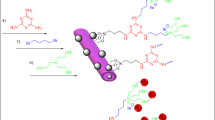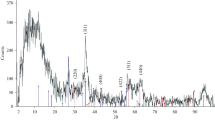Abstract
Magnetite nanoparticles (MNPs) were synthesized on the surface of halloysite nanotubes (HNTs) through co-precipitation approach and the achieved nanocomposites were employed as the support of surface polymerization of [2-(acryloyloxy)ethyl]trimethylammonium chloride (AETAC) to obtain a hybrid adsorbent for removal of Sunset Yellow from wastewater. The resulting magnetic nanocomposite was assessed by several characterizations. The X-ray diffraction (XRD) pattern confirmed the synthesis of Fe3O4 MNPs on HNTs. The field emission scanning electron microscope (FESEM) images showed that spherical Fe3O4 MNPs were successfully synthesized and the energy-dispersive X-ray spectroscopy (EDS) confirmed the presence of Fe element in nanocomposite structure. The solid adsorbent was prepared by the aid of the magnetic HNTs as the support. The vibrating sample magnetometer (VSM) was employed for assessment of the magnetic properties of the magnetic HNTs and the solid polymeric adsorbent. The Freundlich isotherm model was fitted the experimented data better than Langmuir isotherm model, indicating the multi-layer adsorption of the dye to the polymeric adsorbent. The polymeric adsorbent had facile elution procedure by the aid of NaCl solution of 1 M. The prepared adsorbent showed fast separation kinetic, reaching equilibrium in about 15 min. and high absorption capacity of 33.8 µmol/g at room temperature, which made this adsorbent a good candidate for industrial wastewater treatment procedures.






Similar content being viewed by others
Data Availability
The raw/processed data required to reproduce these findings would be available at any time.
References
Afanasjeva J, Gruenberg K (2019) Pharmacists as Environmental Stewards: Strategies for Minimizing and Managing Drug Waste. Sustain Chem Pharm 13:100164
Safavi-Mirmahalleh SA, Salami-Kalajahi M, Roghani-Mamaqani H (2019) Effect of Surface Chemistry and Content of Nanocrystalline Cellulose on Removal of Methylene Blue from Wastewater by Poly(Acrylic Acid)/Nanocrystalline Cellulose Nanocomposite Hydrogels. Cellulose 26:5603–5619
Hassan MM, Bhagvandas M (2017) Sustainable Low Liquor Ratio Dyeing of Wool with Acid Dyes: Effect of Auxiliaries on Agglomeration of Dye Molecules in a Dyebath and Dyeing Uniformity. J Clean Product 152:464–473
Zhang L, Xue W, Gu L (2019) Modification of Hyperbranched Hemicellulose Polymer and Its Application in Adsorbing Acid Dyes. Cellulose 26:5583–5601
Choi S, Cho KH, Namgoong JW, Kim JY, Yoo ES, Lee W, Jung JW, Choi J (2019) The Synthesis and Characterization of The Perylene Acid Dye Inks for Digital Textile Printing. Dyes Pigm 163:381–392
Tang B, Xi C, Zou Y, Wang G, Li X, Zhang L, Chen D, Zhang J (2014) Simultaneous Determination of 16 Synthetic Colorants in Hotpot Condiment by High Performance Liquid Chromatography. J Chromatogr B 960:87–91
El-Sayed GO, Teleb SM, Gouda HM (2017) Decolorization And Degradation of Sunset Yellow in Aqueous Solutions by Advanced Fenton Oxidation. J Bas Environ Sci 4:18–23
Li M, Li R, Tan J, Jiang ZT (2013) Titania-Based Molecularly Imprinted Polymer for Sulfonic Acid Dyes Prepared by Sol-Gel Method. Talanta 107:203–210
Foroughirad S, Arabzadeh N, Mohammadi A, Khosravi A (2018) Synthesis and Characterization of Novel Water-Compatible Magnetic Molecularly Imprinted Polymer for Tartrazine. J Chinese Adv Mater Soc 6:706–721
Abousalman-Rezvani Z, Eskandari P, Roghani-Mamaqani H, Salami-Kalajahi M (2019) Synthesis of Coumarin-containing Multi-Responsive CNC-grafted and Free Copolymers with Application in Nitrate Ion Removal from Aqueous Solutions. Carbohyd Polym 225:115247
Abousalman-Rezvani Z, Eskandari P, Roghani-Mamaqani H, Mardani H, Salami-Kalajahi M (2019) Grafting Light-, Temperature, and CO2-responsive Copolymers from Cellulose Nanocrystals by Atom Transfer Radical Polymerization for Adsorption of Nitrate Ions. Polymer 182:121830
Wan X, Zhan Y, Long Z, Zeng G, He Y (2017) Core@Double shell Structured Magnetic Halloysite Nanotube Nano-Hybrid as Efficient Recyclable Adsorbent for Methylene Blue Removal. Chem Eng J 330:491–504
Heydari R, Hosseini M, Alimoradi M, Zarabi S (2016) A Simple Method for Simultaneous Spectrophotometric Determination of Brilliant Blue FCF and Sunset Yellow FCF in Food Samples after Cloud Point Extraction. J Chem Soc Pakistan 38:438–445
Bai H, Li Z, Zhang S, Wang W, Dong W (2018) Interpenetrating Polymer Networks in Polyvinyl Alcohol/Cellulose Nanocrystals Hydrogels to Develop Absorbent Materials. Carbohyd Polym 200:468–476
Safavi-Mirmahalleh S-A, Salami-Kalajahi M, Roghani-Mamaqani H (2020) Adsorption kinetics of methyl orange from water by pH-sensitive poly(2-(dimethylamino)ethyl methacrylate)/nanocrystalline cellulose hydrogels. Environ Sci Pollut Res 27:28091–28103
Yáñez-Sedeño P, Campuzano S, Pingarrón JM (2017) Electrochemical Sensors Based on Magnetic Molecularly Imprinted Polymers: A Review. Anal Chim Acta 960:1–17
Kim HJ, Koo JM, Kim SH, Hwang SY, Im SS (2017) Synthesis of Super Absorbent Polymer Using Citric Acid as a Bio-based Monomer. Polym Degrad Stab 144:128–136
Arabzadeh N, Khosravi A, Mohammadi A, Mahmoodi NM, Khorasani M (2015) Synthesis, Characterization, and Application of Nano-Molecularly Imprinted Polymer for Fast Solid-Phase Extraction of Tartrazine from Water Environment. Desalin Water Treat 54:2452–2460
Abdollahi E, Abdouss M, Salami-Kalajahi M, Mohammadi A (2016) Molecular Recognition Ability of Molecularly Imprinted Polymer Nano- and Micro-particles by Reversible Addition-fragmentation Chain Transfer Polymerization. Polym Rev 56:557–583
Fizir M, Wei L, Muchuan N, Itatahine A, Mehdi YA, He H, Dramou P (2018) QbD Approach by Computer Aided Design and Response Surface Methodology for Molecularly Imprinted Polymer Based on Magnetic Halloysite Nanotubes for Extraction of Norfloxacin from Real Samples. Talanta 184:266–276
Abdollahi E, Khalafi-Nezhad A, Mohammadi A, Abdouss M, Salami-Kalajahi M (2018) Synthesis of New Molecularly Imprinted Polymer via Reversible Addition Fragmentation Transfer Polymerization as a Drug Delivery System. Polymer 143:245–257
Dai J, Wei X, Cao Z, Zhou Z, Yu P, Pan J, Zou T, Li C, Yan Y (2014) Highly-Controllable Imprinted Polymer Nanoshell at The Surface of Magnetic Halloysite Nanotubes for Selective Recognition and Rapid Adsorption of Tetracycline. RSC Adv 4:7967–7978
Gao B, Cha X, Chen T, Fan L (2015) Designing and Preparing of Acid Dye Surface-Imprinted Material for Effective Removal of Acid Dyes from Water. J Environ Chem Eng 3:277–285
He J, Zou T, Chen X, Dai J, Xie A, Zhou Z, Yan Y (2016) Magnetic Organic-Inorganic Nanocomposite with Ultrathin Imprinted Polymers: via an in Situ Surface-Initiated Approach for Specific Separation of Chloramphenicol. RSC Adv 6:70383–70393
Fizir M, Dramou P, Dahiru NS, Ruya W, Huang T, He H (2018) Halloysite Nanotubes in Analytical Sciences and in Drug Delivery: a Review. Microchim Acta 185:389
Sarsabili M, Parvini M, Salami-Kalajahi M, Ganjeh-Anzabi P (2013) In Situ Reversible Addition-Fragmentation Chain Transfer Polymerization of Styrene in the Presence of MCM-41 Nanoparticles: Comparing “Grafting from” and “Grafting through” Approaches. Adv Polym Technol 32:21372
Rahimi-Razin S, Haddadi-Asl V, Salami-Kalajahi M, Behboodi-Sadabad F, Roghani-Mamaqani H (2012) Properties of Matrix-grafted Multi-Walled Carbon Nanotube/Poly(methyl methacrylate) Nanocomposites Synthesized by In Situ Reversible Addition-Fragmentation Chain Transfer Polymerization. J Iran Chem Soc 9:877–887
Torkpur-Biglarianzadeh M, Salami-Kalajahi M (2015) Multilayer Fluorescent Magnetic Nanoparticles with Dual Thermoresponsive and pH-sensitive Polymeric Nanolayers as Anti-cancer Drug Carriers. RSC Adv 5:29653–29662
Noein L, Haddadi-Asl V, Salami-Kalajahi M (2017) Grafting of pH-sensitive Poly(N, N-Dimethylaminoethyl Methacrylate-Co-2-Hydroxyethyl Methacrylate) onto Halloysite Nanotubes via Surface-Initiated Atom Transfer Radical Polymerization for Controllable Drug Release. Int J Polym Mater Polym Biomater 66:123–131
Li X, Yang Q, Ouyang J, Yang H, Chang S (2016) Chitosan Modified Halloysite Nanotubes as Emerging Porous Microspheres for Drug Carrier. Appl Clay Sci 126:306–312
Li G, Zha J, Niu M, Hu F, Hui X, Tang T, Fizir M, He H (2018) Bifunctional Monomer Molecularly Imprinted Sol-Gel Polymers Based on the Surface of Magnetic Halloysite Nanotubes as an Effective Extraction Approach for Norfloxacin. Appl Clay Sci 162:409–417
Zhang M, Chang L, Yu Z (2018) Fabrication of Halloysite Nanotubes/Polypyrrole Nanocomposites for Efficient Removal of Methyl Orange. Desalin Water Treat 110:209–218
Hemmati K, Masoumi A, Ghaemy M (2016) Tragacanth Gum-based Nanogel as a Superparamagnetic Molecularly Imprinted Polymer for Quercetin Recognition and Controlled Release. Carbohydr Polym 136:630–640
Xu Z, Jiang X, Zhou H, Li J (2018) Preparation of Magnetic Hydrophobic Polyvinyl Alcohol (PVA)–cellulose Nanofiber (CNF) Aerogels as Effective Oil Absorbents. Cellulose 25:1217–1227
Nikravan G, Haddadi-Asl V, Salami-Kalajahi M (2018) Synthesis of pH-responsive Magnetic Yolk-shell Nanoparticles: A Comparison between the Conventional Etching and New Deswelling Approaches. Appl Organometal Chem 32:e4272
Banaei M, Salami-Kalajahi M (2018) A “Grafting to” Approach to Synthesize Low Cytotoxic Poly(aminoamide)-Dendrimer-grafted Fe3O4 Magnetic Nanoparticles. Adv Polym Technol 37:943–948
Zhang M, Zhang Z, Liu Y, Yang X, Luo L, Chen J, Yao S (2011) Preparation of Core-shell Magnetic Ion-imprinted Polymer for Selective Extraction of PB(II) from Environmental Samples. Chem Eng J 178:443–450
Shi S, Guo J, You Q, Chen X, Zhang Y (2014) Selective and Simultaneous Extraction and Determination of Hydroxybenzoic Acids in Aqueous Solution by Magnetic Molecularly Imprinted Polymers. Chem Eng J 243:485–493
Bonetto LR, Ferrarini F, De Marco C, Crespo JS, Guégan R, Giovanela M (2015) Removal of Methyl Violet 2B Dye from Aqueous Solution Using a Magnetic Composite as an Adsorbent. J Water Process Eng 6:11–20
Riahi-Madvaar R, Taher MA, Fazelirad H (2017) Synthesis and Characterization of Magnetic Halloysite-Iron Oxide Nanocomposite and Its Application for Naphthol Green B Removal. Appl Clay Sci 137:101–106
Kiani G, Dostali M, Rostami A, Khataee AR (2011) Adsorption Studies on the Removal of Malachite Green from Aqueous Solutions onto Halloysite Nanotubes. Appl Clay Sci 54:34–39
Sharifzadeh E, Salami-Kalajahi M, Hosseini MS, Aghjeh MKR (2016) A Temperature-Controlled Method to Produce Janus Nanoparticles Using High Internal Interface Systems: Experimental and Theoretical Approaches. Colloids Surf A Physicochem Eng Asp 506:56–62
Pal P, Kundu MK, Malas A, Das CK (2014) Compatibilizing Effect of Halloysite Nanotubes in Polar-Nonpolar Hybrid System. J Appl Polym Sci 131:1–10
Duan J, Liu R, Chen T, Zhang B, Liu J (2012) Halloysite Nanotube-Fe3O4 Composite for Removal of Methyl Violet from Aqueous Solutions. Desalination 293:46–52
Ferrarini F, Bonetto LR, Crespo JS, Giovanela M (2016) Removal of Congo Red Dye from Aqueous Solutions Using a Halloysite-Magnetite-Based Composite. Water Sci Technol 73:2132–2142
Robati D, Rajabi M, Moradi O, Najafi F, Tyagi I, Agarwal S, Gupta VK (2016) Kinetics and Thermodynamics of Malachite Green Dye Adsorption from Aqueous Solutions on Graphene Oxide and Reduced Graphene Oxide. J Mol Liq 214:259–263
Jiang L, Zhang C, Wei J, Tjiu W, Pan J, Chen Y, Liu T (2014) Surface Modifications of Halloysite Nanotubes with Superparamagnetic Fe3O4 nanoparticles and Carbonaceous Layers for Efficient Adsorption of Dyes in Water Treatment. Chem Res Chinese Univ 30:971–977
Yin Y, Pan J, Cao J, Ma Y, Pan G, Wu R, Dai X, Meng M, Yan Y (2016) Rationally Designed Hybrid Molecularly Imprinted Polymer Foam for Highly Efficient Λ-cyhalothrin Recognition and Uptake via Twice Imprinting Strategy. Chem Eng J 286:485–496
Huang Z, Li Y, Chen W, Shi J, Zhang N, Wang X, Li Z, Gao L, Zhang Y (2017) Modified Bentonite Adsorption of Organic Pollutants of Dye Wastewater. Mater Chem Phys 202:266–276
Konicki W, Aleksandrzak M, Mijowska E (2017) Equilibrium, Kinetic and Thermodynamic Studies on Adsorption of Cationic Dyes from Aqueous Solutions Using Graphene Oxide. Chem Eng Res Des 231:35–49
Kurczewska J, Cegłowski M, Schroeder G (2019) Alginate/PAMAM Dendrimer – Halloysite Beads for Removal of Cationic and Anionic Dyes. Int J Biol Macromol 123:398–408
Xie Y, Qian D, Wu D, Ma X (2011) Magnetic Halloysite Nanotubes/Iron Oxide Composites for The Adsorption of Dyes. Chem Eng J 168:959–963
Funding
This research did not receive any specific grant from funding agencies in the public, commercial, or not-for-profit sectors.
Author information
Authors and Affiliations
Contributions
Sahar Foroughirad. Methodology, Formal analysis, Investigation, Writing—Original Draft, Visualization.Vahid Haddadi-Asl.Conceptualization, Validation, Data Curation, Writing—Review & Editing, Supervision, Project administration, funding acquisition. Alireza Khosravi. Validation, Data curation, Supervision, funding acquisition. Mehdi Salami-Kalajahi. Validation, Data Curation, Writing—Review & Editing.
Corresponding author
Additional information
Publisher’s Note
Springer Nature remains neutral with regard to jurisdictional claims in published maps and institutional affiliations.
Supporting information: Materials; Characterizations; Apparatus; Calibration curve.
Electronic supplementary material
Below is the link to the electronic supplementary material.
Rights and permissions
About this article
Cite this article
Foroughirad, S., Haddadi-Asl, V., Khosravi, A. et al. Synthesis of magnetic nanoparticles-decorated halloysite nanotubes/poly([2-(acryloyloxy)ethyl]trimethylammonium chloride) hybrid nanoparticles for removal of Sunset Yellow from water. J Polym Res 27, 320 (2020). https://doi.org/10.1007/s10965-020-02293-0
Received:
Accepted:
Published:
DOI: https://doi.org/10.1007/s10965-020-02293-0




